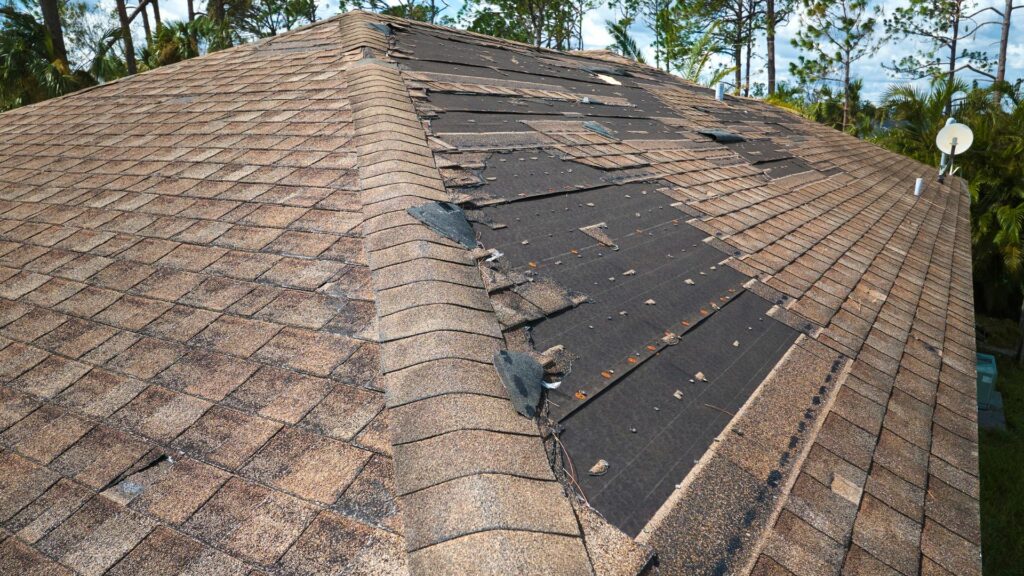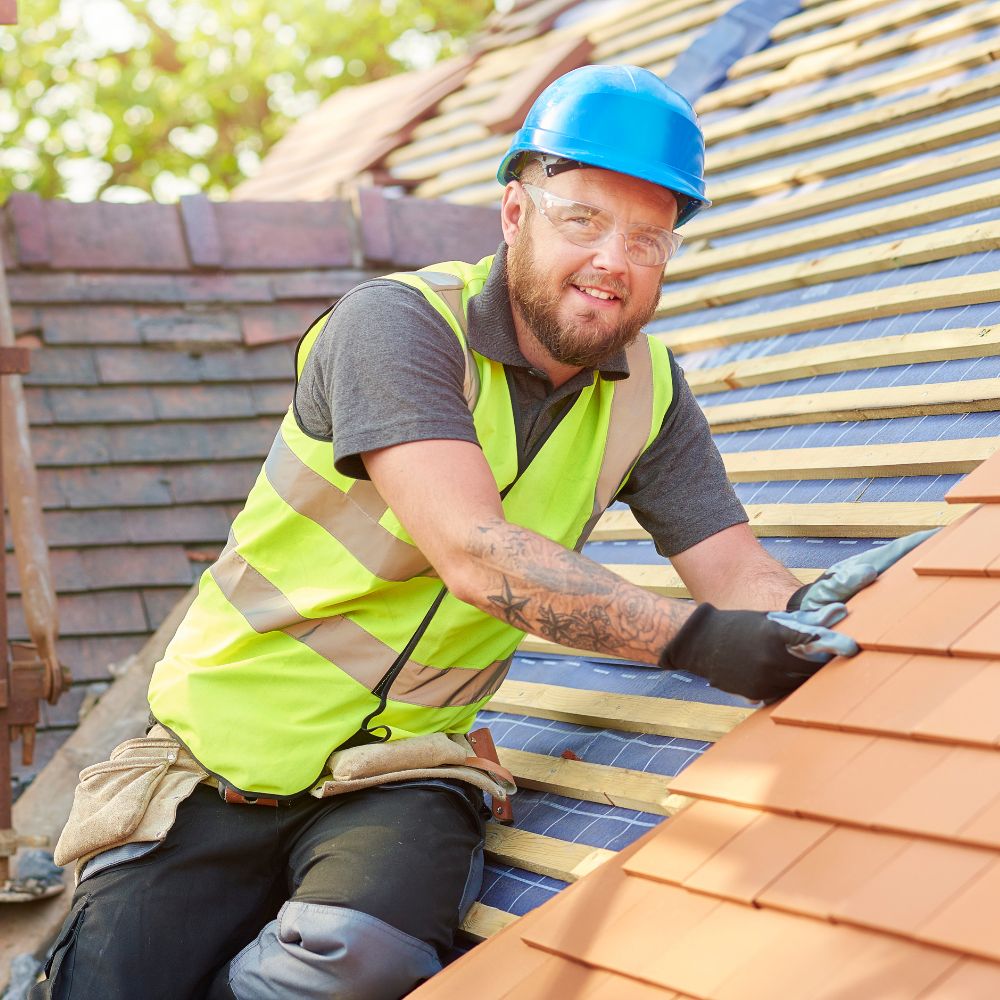Your roof protects your property from the elements, providing shelter and security for you, your loved ones, or your coworkers. Over time, however, exposure to weather conditions and wear and tear can take a toll on your roof’s structural integrity. As a responsible property owner, it’s essential to be vigilant about your roof’s condition to ensure it continues to protect those underneath it.
In this blog, we’ll explore seven telltale signs it’s time to consider repairing or replacing your roof. By recognizing these warning signals early on, you can quickly address potential issues, saving yourself from costly repairs and safeguarding your property’s value and safety.
Sign #1: Missing shingles
Missing shingles are a clear sign that your roof requires immediate attention. When shingles go missing, the underlying roofing materials are exposed to harsh weather conditions, including rain, wind, and UV rays. This vulnerability compromises the roof’s ability to protect your property from water infiltration and potential structural damage.
Additionally, missing shingles can create weak points that may lead to leaks, causing rot and mold growth in the underlying structure. Ignoring the issue can exacerbate the problem, resulting in more significant damage and potentially requiring a total roof replacement. Addressing missing shingles preserves the roof’s integrity and extends its lifespan, ensuring it safeguards your property for years.

Sign #2: Excessive granular loss
Excessive granular loss on your roof’s shingles is another red flag that demands your attention. As shingles age, they naturally lose some granules due to weathering and exposure to the elements. However, when granule loss becomes excessive, it indicates significant wear and tear, which can compromise the shingles’ functionality.
These granules protect the shingles from harmful UV rays and other weather-related damage. With granule loss, the shingles become more susceptible to cracking, curling, and deteriorating, leaving your roof vulnerable to leaks.
If left unaddressed, the weakened shingles can further damage the roof’s structure and may necessitate a complete roof replacement. Therefore, it’s essential to address excessive granular loss by repairing or replacing affected shingles.

Sign #3: Recurring leaks
Recurring leaks in your roof are an unmistakable sign that your roof requires immediate repair or replacement. Leaks indicate that the roof’s protective barrier has been compromised, allowing water to infiltrate your space.
While some leaks may be small and seemingly insignificant, they can lead to extensive damage over time if not addressed promptly. Persistent leaks can result from various issues, such as damaged shingles, worn-out flashing, or deteriorated underlayment. If you don’t resolve these leaks, they can lead to structural damage and mold growth, putting your safety at risk.
In such cases, a thorough inspection by a professional roofing contractor is essential to identify the root cause and determine the most appropriate course of action. However, it’s important to note that even if you have a significant roof leak, that doesn’t mean you automatically need a new roof. A qualified roofer should assess your roof before offering an honest recommendation—rather than simply trying to ensure you pay for a full replacement.

Sign #4: Saturated substrate
Saturated substrate from persistent leaks is a critical indicator that your roof needs inspecting. The substrate, typically made of wood or plywood, forms the foundation for your roof, providing essential support and stability. When the substrate becomes saturated, it indicates water penetration and potential damage to the roof’s structure.
This moisture can lead to wood rot, weakening the substrate and compromising the overall strength of your roof. If left unaddressed, a saturated substrate can escalate into more extensive problems, such as sagging, mold growth, and safety hazards. Repairing the affected area and addressing the source of water infiltration is essential to prevent further deterioration.
Sometimes, if the saturation and damage are severe, a roof replacement may be necessary. Regular roof inspections and proactive maintenance can help identify substrate issues early and save you from costly repairs or replacements down the road.

Sign #5: Excessive cupping or curling of shingles
Excessive cupping or curling of shingles is another sign that your roof needs repairing or replacing, as it points to significant wear and tear on the roofing materials. Cupping refers to the shingles’ edges turning upward, resembling a cup shape, while curling involves the shingles’ edges curling downward or upward. Both issues are often caused by prolonged exposure to harsh weather conditions, UV rays, and poor ventilation.
When shingles cup or curl, they become more vulnerable to water infiltration, wind damage, and potential detachment from the roof. As a result, your property becomes susceptible to leaks, leading to water damage and mold growth within the structure. Ignoring these signs can escalate the problem, potentially requiring a complete roof replacement.

Sign #6: Brittle roofing material
If you have any sort of brittle roofing material, it’s time for an inspection. Roofing materials can become brittle over time due to prolonged exposure to the elements, extreme temperatures, and the natural aging process. When roofing material becomes brittle, it loses its flexibility and becomes more susceptible to cracking and breaking. This compromises the material’s ability to protect your home from weather elements, including rain, wind, and hail.
Additionally, brittle roofing material is less resistant to expansion and contraction, which can lead to leaks and further damage during temperature fluctuations. If left unaddressed, brittle roofing material can result in water seepage and structural damage. To ensure your Midwest roof stays safe, it’s crucial to inspect for signs of brittleness and meet with a professional roofer should you find any.

Sign #7: Surpassing life expectancy
Different roofing materials have various life expectancies, but you can typically expect the following lifespans:
- Wood shake: 20-40+ years
- Slate: 100+ years
- Clay tile: 100+ years
- Shingles: 20-50 years
- Composite roofing: 50+ years
- TPO (Thermoplastic Polyolefin) and EPDM (ethylene propylene diene terpolymer): 20-25 years
- Metal roofing: 30-50 years
- Copper roofing: 70-90 years
A residential or commercial roof that surpasses its life expectancy typically requires a complete replacement. As a roof nears or exceeds its expected lifespan, it becomes more susceptible to wear and tear, making it less effective at protecting your property. Roofing materials may deteriorate, lose structural integrity, and become prone to leaks and other damage.
Ignoring the signs of an aging roof can lead to costly repairs and potential hazards. That’s why it’s essential to work with a professional roofer who can help you extend the life of your roof or let you know if a complete replacement is necessary.

Finding the right professional roofing team
At Duration Construction, we often see roofs that need simple repairs when other contractors have told the owners their roof needs replacing. We pride ourselves on offering honest recommendations, so you’re not stuck with a bill that could have been cut in half.
Many of our customers wonder how much a typical set of roof repairs or a full replacement costs. Typically, this depends on what exactly needs to be done. Our team of contractors will inspect your roof first, providing feedback on what needs fixing. Each roof is unique, and an estimate is required to determine the final cost.
If you think your roof needs repairs or a replacement, the team at Duration Construction offers free yearly inspections and a free consultation. We’ll walk through your questions and provide personalized advice to help you confidently move forward. Schedule your free inspection today!
